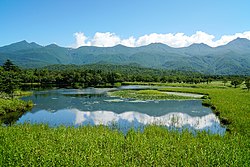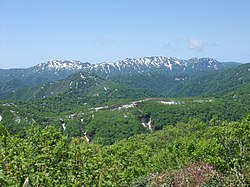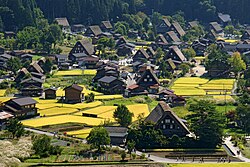Tourism in Japan
 From Wikipedia - Reading time: 16 min
From Wikipedia - Reading time: 16 min


Tourism in Japan is a major industry and contributor to the Japanese economy. In 2019, the sector directly contributed 11 trillion yen (US$100 billion), or 2% of the GDP, and attracted 31.88 million international tourists.[1][2][3] In 2024, 36.9 million international tourists visited Japan.[4][5][6]
There are 26 World Heritage Sites in Japan, including Himeji Castle, Historic Monuments of Ancient Kyoto and Nara. Popular attractions for foreigners include Tokyo and Osaka, Mount Fuji, Kyoto, Hiroshima, Nagasaki, ski resorts such as Niseko in Hokkaido, Okinawa, riding the Shinkansen and taking advantage of Japan's hotel and hotspring network.
The 2024 Travel and Tourism Competitiveness Report ranked Japan 3rd out of 141 countries overall, which was the highest in Asia. Japan gained relatively high scores in almost all of the featured aspects, such as health and hygiene, safety and security, cultural resources and business travel.[7]
History
[edit]
From the middle ages to early modern period
[edit]In medieval Japan, travel became increasingly common with cultural and aristocratic figures from Kyoto, and they initiated the genre of travel literature in Japan. Notable examples of travel literature from this period include the Tosa Nikki (935), part of the Sarashina Nikki (12th century), and the volume 4 of the Tohazugatari (1313).[8] By the late medieval period, supported by a network of inns offering fixed-rate lodging and meals, travel was widespread. Hot springs such as Kusatsu, Arima, and Gero gained fame, attracting notable figures such as warriors and monks. Tourist souvenirs including ladles and toothpicks were popular among visitors. Pilgrimages to Mount Fuji also flourished.[9]

During the Edo period, despite restrictions on travelling through checkpoints, guidebooks facilitated the popularisation of travel. Commoners with permits could undertake leisure trips, often disguised as pilgrimages. Inns, teahouses, and local products thrived, and travel information spread via diaries and ukiyo-e prints. Pilgrimages such as the Ise Grand Shrine’s Okage Mairi became major social phenomena, marking the beginnings of a modern tourism industry. However, foreign travel was extremely rare due to Japan's isolation policy. Matsuo Bashō's 1689 trip to the then "far north" of Japan, which inspired his famous haibun work Oku no Hosomichi, occurred not long after Hayashi Razan categorized the Three Views of Japan in 1643. During this time, Japan was a closed country to foreigners, so no foreign tourism existed in Japan.
Meiji era and international tourism
[edit]
Japan opened its borders in the late Edo period, but due to its location in the Far East and the limited transport options, there were not many foreign visitors. Foreigners eventually gained the freedom to travel within Japan, and efforts to actively attract international tourists began on the Japanese side. In 1912, the Japan Travel Bureau (JTB) was established. Another major milestone in the development of the tourism industry in Japan was the 1907 passage of the Hotel Development Law, as a result of which the Railways Ministry began to construct publicly owned hotels throughout Japan.[10] During the interwar period, overseas travel to distant places such as Europe and the Americas was primarily limited to businesspeople, immigrants, and students, with leisure travel being mostly reserved for the wealthy.
In terms of domestic tourism, the dismantling of the feudal system, the development of transport networks such as railways and steamships, and the spread of information made domestic travel easier. Tourism-oriented travel became increasingly popular, and regions across Japan began developing themselves for sightseeing and leisure purposes. Long-distance domestic travel became accessible.
Postwar period
[edit]During the postwar Allied occupation period, most foreign tourists in Japan were GHQ personnel or visitors from the United States. In 1954, Konosuke Matsushita, the founder of Panasonic, contributed an article titled The Case for a Tourism-Oriented Nation to the Bungei Shunju. Matsushita argued that tourism could be considered a form of trade, and he pointed out that while exporting goods involves depleting Japan's resources, scenic attractions such as Mount Fuji and the Seto Inland Sea remain unchanged no matter how often they are viewed. He proposed that revenue earned through inbound tourism could be reinvested in other industries, and help rebuild the country's economy beyond its pre-war stature.[11]

For much of post-war period, Japan has been an exceptionally unattractive tourist destination for its population and GDP size. According to the IMF, WTO, and OECD, from 1995 to 2014, it was by far the least visited country.[12] As of 2013, Japan was one of the least visited countries in the OECD on a per capita basis.[13] Japan avoided campaigns to attract inbound tourists, especially because its large current account surplus had caused international friction with some countries. There were also factors such as Japan being the world's most expensive countries at the time (for example, Tokyo was rated by the Economist Intelligence Unit as the most expensive city in the world for 14 years in a row ending in 2006), as well as the language barrier.[14]
Active promotion of inbound tourism (21st century)
[edit]From 2013, under the Abe administration, policies to attract international tourists were implemented to offset the shrinking domestic demand caused by population decline and ageing. As a result, by 2014, for the first time in 55 years, income from foreign tourists exceeded the amount spent by Japanese tourists abroad, which means Japan finally ran a tourism surplus. Within six years, the number of international visitors has more than tripled, reaching 31.9 million visitors in 2019.[15] Japan received a record 36.87 million tourist arrivals in 2024, an increase of over 47% from the year prior.
Current status
[edit]Domestic tourism remains a vital part of Japanese economy and Japanese culture. Across the nation, Japanese children in many middle schools see the highlight of their years as a visit to Tokyo Tower, Yomiuriland, Tokyo Disneyland, Sensō-ji, and/or Tokyo Skytree, and many high school students often visit Okinawa or Hokkaido. The extensive rail network together with domestic flights sometimes in planes with modifications to favor the relatively short distances involved in intra-Japan travel allows efficient and speedy transport. International tourism plays a smaller role in the Japanese economy compared to other developed countries; in 2013, international tourist receipts was 0.3% of Japan's GDP, while the corresponding figure was 1.3% for the United States and 2.3% for France. In 2019, the value was up to 1.0% of GDP, driven by an increase in international tourism, while the country's GDP has remained stable.[16][17]
Tourists from South Korea have made up the largest number of inbound tourists several times in the past. In 2010, their 2.4 million arrivals made up 27% of the tourists visiting Japan.[18] Travelers from China have been the highest spenders in Japan by country, spending an estimated 196.4 billion yen (US$2.4 billion) in 2011, or almost a quarter of total expenditure by foreign visitors, according to data from the Japan Tourism Agency.[19] From 2016 to 2020, Japanese government hoped to receive 40 million foreign tourists every year by 2020.[20] According to the Japan National Tourism Organization in 2017, 3 out of 4 foreign tourists came from other parts of East Asia, namely South Korea, mainland China, Taiwan and Hong Kong.[21] Japanese film, TV, video game, and manga/anime industries play a role in driving tourism to Japan. In surveys held by Statista between 2019 and 2020, 24.2% of tourists from the United States, said they were motivated to visit Japan because of Japanese popular culture.[22]
Overtourism
[edit]Following the easing of COVID-19-era travel restrictions, 2024 is on track to be a record-breaking year for the number of overseas tourists.[23] This tourism boom can be attributed in part to the weakening Japanese yen.[23] The unprecedented number of foreign tourists has led to claims that some parts of Japan are suffering from overtourism.[23][24]
In response to this surge, officials in some parts of Japan have introduced measures to counter its negative effects. For example, Yamanashi Prefecture has set a cap of daily climbers of Mount Fuji at 4,000 people and began charging an entrance fee of ¥2,000.[24] Also in Yamanashi Prefecture, a mesh barrier was set up to block a view of Mount Fuji behind a Lawson convenience store in Fujikawaguchiko due to tourist-caused disturbances in the area.[25]
As of 2024, some Japanese officials have considered instituting a two-tiered pricing system which would have foreign tourists pay more than residents at certain tourist attractions in order to counter the effects of overtourism.[26][27]
Tourism statistics
[edit]
These are the top 35 nationalities that visited Japan from 2017 to 2024.[28][29]
| Country/Territory | Total | |||||||
|---|---|---|---|---|---|---|---|---|
| 2024 | 2023 | 2022 | 2021 | 2020 | 2019 | 2018 | 2017 | |
| 8,817,765 | 6,958,494 | 1,012,751 | 18,947 | 694,476 | 5,584,597 | 7,538,952 | 7,140,200 | |
| 6,981,342 | 2,425,157 | 189,125 | 42,239 | 1,069,256 | 9,594,394 | 8,380,034 | 7,355,800 | |
| 6,044,316 | 4,202,434 | 331,097 | 5,016 | 487,939 | 4,890,602 | 4,757,258 | 4,564,100 | |
| 2,683,391 | 2,114,402 | 269,285 | 1,252 | 346,020 | 2,290,792 | 2,207,804 | 2,231,500 | |
| 2,724,594 | 2,045,854 | 323,513 | 20,026 | 219,307 | 2,187,557 | 1,939,719 | 1,756,732 | |
| 1,148,848 | 995,558 | 198,037 | 2,758 | 219,830 | 1,318,977 | 1,132,160 | 987,100 | |
| 920,196 | 613,062 | 88,648 | 3,265 | 143,508 | 621,771 | 552,440 | 496,100 | |
| 818,659 | 622,293 | 126,842 | 5,625 | 109,110 | 613,114 | 503,976 | 424,200 | |
| 691,226 | 591,267 | 131,969 | 857 | 55,273 | 492,252 | 437,280 | 404,100 | |
| 621,173 | 573,916 | 284,113 | 26,586 | 152,559 | 495,051 | 389,004 | 308,900 | |
| 579,445 | 425,874 | 55,877 | 3,536 | 53,365 | 375,262 | 330,600 | 305,591 | |
| 517,651 | 429,382 | 119,723 | 5,209 | 77,724 | 412,779 | 396,852 | 352,200 | |
| 506,883 | 415,712 | 74,095 | 1,831 | 76,573 | 501,592 | 468,360 | 439,500 | |
| 437,230 | 321,482 | 57,496 | 7,294 | 51,024 | 424,279 | 333,979 | 310,499 | |
| 385,071 | 277,436 | 52,782 | 7,024 | 43,102 | 336,333 | 304,896 | 268,605 | |
| 325,870 | 233,410 | 45,748 | 5,197 | 29,785 | 236,544 | 215,336 | 195,606 | |
| 233,061 | 166,394 | 54,314 | 8,831 | 26,931 | 175,896 | 154,029 | 134,371 | |
| 229,785 | 152,305 | 23,683 | 3,527 | 13,691 | 162,769 | 150,060 | 125,864 | |
| 182,284 | 115,873 | 15,926 | 3,053 | 11,741 | 130,243 | 118,901 | 99,814 | |
| 151,835 | 94,684 | 9,152 | 1,124 | 9,528 | 71,745 | 68,448 | 63,440 | |
| 123,779 | 74,252 | 1,359 | 54 | 12,234 | 121,197 | 108,694 | 115,304 | |
| 115,012 | 78,978 | 12,107 | 1,404 | 16,070 | 94,115 | 73,208 | 64,873 | |
| 111,568 | 83,302 | 75,200 | 11,648 | 17,191 | 51,577 | 44,297 | 39,950 | |
| 102,981 | 74,486 | 12,064 | 1,860 | 8,481 | 79,479 | 72,069 | 63,041 | |
| 99,264 | 41,965 | 10,324 | 3,723 | 22,260 | 120,043 | 94,810 | 77,251 | |
| 85,609 | 50,570 | 9,436 | 2,731 | 6,888 | 47,575 | 44,201 | 42,207 | |
| 72,193 | 53,395 | 8,917 | 1,387 | 6,036 | 53,908 | 52,099 | 47,154 | |
| 70,597 | 45,815 | 22,763 | 1,531 | 10,884 | 30,977 | 24,418 | 22,915 | |
| 63,828 | 40,634 | 5,745 | 1,350 | 3,996 | 38,534 | 34,706 | 28,727 | |
| 62,099 | 31,198 | 7,129 | 1,161 | 2,886 | 22,724 | 19,762 | 19,123 | |
| 59,499 | 45,143 | 7,673 | 619 | 2,315 | 44,214 | 39,193 | 32,758 | |
| 53,049 | 39,916 | 19,267 | 1,685 | 7,118 | 31,513 | 27,647 | 23,365 | |
| 52,099 | 39,245 | 7,900 | 1,112 | 7,622 | 53,836 | 53,822 | 50,805 | |
| 49,015 | 36,742 | 21,536 | 3,127 | 8,918 | 28,380 | 27,789 | 27,904 | |
| 47,063 | 34,352 | 6,611 | 1,122 | 4,074 | 39,245 | 34,387 | 32,054 | |
| 42,300 | 27,812 | 3,176 | 728 | 3,179 | 32,349 | 26,506 | 23,442 | |
| 40,950 | 30,780 | 5,403 | 794 | 4,780 | 32,893 | 29,163 | 25,235 | |
| 36,820 | 26,360 | 5,025 | 888 | 3,605 | 27,530 | 24,187 | 21,035 | |
| 32,995 | 22,985 | 4,458 | 820 | 3,270 | 39,387 | 20,319 | 18,591 | |
| 28,901 | 21,541 | 3,736 | 557 | 3,620 | 24,838 | 22,569 | 20,786 | |
| 28,780 | 21,404 | 4,608 | 736 | 4,859 | 29,437 | 27,116 | 25,310 | |
| 27,314 | 27,067 | 13,618 | 784 | 7,420 | 28,492 | 21,696 | 17,857 | |
| 23,896 | 19,559 | 11,981 | 1,789 | 4,444 | 15,174 | 13,971 | 12,878 | |
| 23,710 | 21,132 | 11,423 | 4,284 | 6,145 | 17,208 | 15,802 | 13,729 | |
| 22,765 | 15,316 | 2,376 | 552 | 1,409 | 14,837 | 12,250 | 10,390 | |
| 19,924 | 13,958 | 2,487 | 753 | 1,679 | 14,356 | 12,255 | 11,114 | |
| 19,809 | 13,177 | 2,198 | 798 | 4,220 | 23,805 | 23,692 | 18,610 | |
| 18,460 | 13,808 | 1,902 | 276 | 3,381 | 13,370 | 14,089 | 11,027 | |
| 17,443 | 12,380 | 2,403 | 1,039 | 11,152 | 7,403 | 7,554 | 7,587 | |
| 15,827 | 11,316 | 2,511 | 1,034 | 1,302 | 12,696 | 10,440 | 9,148 | |
| 15,602 | 9,598 | 1,495 | 476 | 1,098 | 11,745 | 9,966 | 8,795 | |
| 14,885 | 9,969 | 1,869 | 744 | 1,091 | 9,494 | 7,968 | 6,703 | |
| 14,512 | 10,270 | 2,705 | 203 | 770 | 8,891 | 7,782 | 7,106 | |
| 12,541 | 9,357 | 2,561 | 838 | 1,623 | 19,543 | 9,793 | 9,057 | |
| 10,375 | 8,571 | 1,511 | 601 | 890 | 5,431 | 4,391 | 4,125 | |
| 9,387 | 7,145 | 2,152 | 746 | 720 | 5,252 | 5,161 | 6,457 | |
| 9,480 | 6,360 | 1,024 | 338 | 627 | 6,324 | 5,106 | 4,529 | |
| 9,412 | 6,749 | 3,795 | 1,070 | 1,466 | 10,176 | 8,458 | 7,094 | |
| 9,377 | 6,226 | 1,286 | 272 | 672 | 5,260 | 4,498 | 4,177 | |
| 9,068 | 8,075 | 5157 | 1,567 | 1,290 | 5,243 | 5,530 | 4,380 | |
| 7,429 | 6,359 | 1,804 | 150 | 1,169 | 6,154 | 5,987 | 5,398 | |
| 7,335 | 6,292 | 1,159 | 23 | 742 | 4,866 | 3,626 | 3,699 | |
| 7,080 | 4,816 | 2,223 | 1,187 | 1,294 | 6,345 | 4,942 | 4,283 | |
| 6,582 | 5,195 | 1,196 | 254 | 1,191 | 6,022 | 5,048 | 4,549 | |
| 6,078 | 4,067 | 634 | 414 | 470 | 4,099 | 3,407 | 3,084 | |
| 6,038 | 3,779 | 676 | 308 | 493 | 3,347 | 3,187 | 3,027 | |
| Total (all countries) | 36,870,148 | 25,066,350 | 3,832,110 | 245,862 | 4,115,828 | 31,882,049 | 31,191,856 | 28,690,900 |
Major tourist destinations
[edit]You can help expand this article with text translated from the corresponding article in Japanese. (October 2013) Click [show] for important translation instructions.
|










Hokkaido
[edit]- Niseko Ski Resort
- Shiretoko Peninsula (WHS)
- Teshikaga – Lake Mashū, Lake Kussharo
- Tōya Caldera and Mount Usu Geopark
- Daisetsuzan Volcanic Group
- Hakodate
- Otaru
Tōhoku region
[edit]- Shirakami-Sanchi (WHS)
- Mount Osore
- Lake Towada
- Hirosaki – Hirosaki Castle, Nakacho Samurai District
- Hiraizumi – Chūson-ji, Mōtsū-ji, Kanjizaiō-in, Takkoku-no-Iwaya
- Semboku – Kakunodate Samurai District, Lake Tazawa, Nyūtō Onsen
- Yamagata – Yama-dera Temple, Zaō Onsen
- Matsushima
Kantō region
[edit]- Nikkō – Shrines and Temples of Nikkō (WHS), Kegon Falls, Lake Chūzenji, Cedar Avenue of Nikko
- Tomioka Silk Mill (WHS)
- Kinugawa Onsen – Edo Wonderland Nikko Edomura, Tobu World Square
- Utsunomiya – Oya stone museum, Utsunomiya Futarayama Shrine
- Ashikaga, Tochigi – Ashikaga Gakkō, Ashikaga Flower Park
- Tokyo – Imperial Palace, Asakusa, Akihabara, Ginza, Harajuku/Omotesandō, Nakano Broadway, Shibuya, Shinjuku, Tsukiji Fish Market, Ueno Park, Fujiko F. Fujio Museum, Studio Ghibli Museum
- Tokyo Disney Resort
- Kamakura – Tsurugaoka Hachiman-gū, Kōtoku-in, Kenchō-ji, Engaku-ji, Meigetsu-in, Hase-dera
- Kusatsu Onsen
- Hakone Onsen
Chūbu region
[edit]- Mount Fuji
- Japanese Alps – Tateyama Kurobe Alpine Route(Mount Tate), Hida Mountains, Kiso Mountains, Akaishi Mountains
- Kurobe Gorge Railway
- Shiga Kōgen
- Matsumoto – Matsumoto Castle, Mount Hotaka, Kamikōchi
- Shirakawa-gō and Gokayama (WHS)
- Takayama – Sanmachi Traditional Street, Ōshinmachi Traditional Street, Higashiyama Temple Area
- Kanazawa – Kenroku-en Garden, Kanazawa Castle, Higashi Geisha District, Nagamachi Samurai District
- Sakai – Tōjinbō, Maruoka Castle
- Nagoya – Nagoya Castle, Atsuta Shrine, Sakae, Nagoya Station (Meieki), Ōsu Kannon temple
Kansai region
[edit]- Kyoto – Kinkaku-ji, Ginkaku-ji, Kiyomizu-dera, Ryōan-ji, Sanjūsangen-dō, etc., they are parts of Historic Monuments of Ancient Kyoto (WHS)
- Uji – Byōdō-in and Ujigami Shrine (WHS), Relation of The Tale of Genji
- Ōtsu – Lake Biwa, Hiyoshi Taisha, Sakamoto Temple District, Mount Hiei, Enryaku-ji (WHS)
- Ōmihachiman – Traditional Riverside District
- Nara – Tōdai-ji, Tōshōdai-ji, Kōfuku-ji, Yakushi-ji, Heijō Palace, Kasuga-taisha and Nara Park, etc. They are parts of the Historic Monuments of Ancient Nara (WHS).
- Ikaruga – Hōryū-ji and Hōki-ji are Buddhist Monuments in the Hōryū-ji Area (WHS).
- Yoshino (Mount Yoshino) – Kimpusen-ji, Yoshimizu Shrine, Yoshino Mikumari Shrine, etc. They are parts of the Sacred Sites and Pilgrimage Routes in the Kii Mountain Range (WHS).
- Shingū – Kumano Hayatama Taisha and Kumano River (WHS)
- Nachikatsuura – Nachi Falls, Kumano Kodō, etc., they are parts of Sacred Sites and Pilgrimage Routes in the Kii Mountain Range (WHS)
- Mount Kōya – Kongōbu-ji (WHS)
- Osaka – Osaka Castle, Umeda, Namba, Dōtonbori, Shinsaibashi, Shinsekai, Shitennō-ji, Sumiyoshi-taisha, Universal Studios Japan, Kaiyukan, Rinku Town, Den-Den Town, Expo Commemoration Park, Kamagasaki[30]
- Himeji – Engyō-ji, Koko-en Garden, and Himeji Castle (WHS)
- Kobe – Port of Kobe, Rokkō Mountains, Kitano-chō, Arima Onsen, Kobe Luminarie
- San'in Kaigan Geopark – Toyooka, Izushi, Kinosaki Onsen, Yumura Onsen
Chūgoku region
[edit]- Hiroshima Prefecture – Itsukushima Shrine (WHS), Onomichi, Tomonoura
- Okayama Prefecture – Kurashiki, Kōrakuen Garden, Okayama Castle
- Tottori Prefecture – Tottori Sand Dunes, Mount Daisen, Mount Hyōno, San'in Kaigan Geopark
- Shimane Prefecture – Iwami Ginzan Silver Mine (WHS), Izumo-taisha, Matsue Castle, Oki Islands, Tsuwano
- Yamaguchi Prefecture – Hagi
Shikoku
[edit]- Shikoku Pilgrimage (Zentsū-ji, Motoyama-ji, etc.)
- Ehime Prefecture – Dōgo Onsen, Matsuyama Castle
- Kagawa Prefecture – Kotohira-gū Shrine, Ritsurin Garden, Shōdo Island, Naoshima Island
- Tokushima Prefecture – Naruto whirlpools, Awa Dance Festival in Tokushima
- Kōchi Prefecture – Kōchi Castle, Cape Muroto (Muroto Geopark), Cape Ashizuri
Kyushu and Okinawa
[edit]- Fukuoka Prefecture – Mojiko Retro Town, Kokura Castle, Dazaifu Tenman-gū, Remains of Dazaifu (government)
- Ōita Prefecture – Many types of hot springs in Beppu, Ōita or Yufuin, Ōita, Usa jingū, stone bridges, small stonehenge on the top of Komekamiyama (mountain), Hello Kitty Harmonyland
- Nagasaki Prefecture – Ōura Church, Higashi-Yamate, Minami-Yamate including the Glover Garden, Huis Ten Bosch (theme park), Hidden Christian Sites (WHS)
- Kagoshima Prefecture – Yakushima (WHS), Sakurajima, Amami Ōshima
- Miyazaki Prefecture – Kirishima-Yaku National Park, Takachiho, Old Exculibur on the top of Takachiho-kyo mountain, Nichinan, Miyazaki, Chambered barrows of Saitobaru kofungun, Heiwadai Park
- Kumamoto Prefecture – Kumamoto Castle, Mount Aso
- Saga Prefecture – Pre-400 BC Yayoi archaeological site in Yoshinogari site
- Okinawa Prefecture – Shuri Castle, Nakagusuku Castle, Nakijin Castle, etc. They are parts of the Gusuku Sites and Related Properties of the Kingdom of Ryukyu. (WHS), Ishigaki Island, Miyako Island, Iriomote Island, Traditional Ryukyuan Houses in Taketomi Island
See also
[edit]- Groups of Traditional Buildings
- Japanese museums
- List of National Geoparks in Japan
- List of Special Places of Scenic Beauty, Special Historic Sites and Special Natural Monuments
- World Heritage Sites in Japan
- List of museums in Japan
- National Treasures of Japan
- Omiyage
- Ryokan (Japanese inn)
- Visa policy of Japan
References
[edit]- ^ "International tourism, number of arrivals - Japan | Data".
- ^ [1]
- ^ "Tourism White Paper 2019". www.mlit.go.jp. Retrieved December 5, 2024.
- ^ "International tourism, number of arrivals - Japan | Data".
- ^ [2]
- ^ "Tourism White Paper 2019". www.mlit.go.jp. Retrieved December 5, 2024.
- ^ "Travel & Tourism Development Index 2024" (PDF). World Economic Forum. May 21, 2024.
- ^ Inada, Toshinori (June 1994). "中世紀行文学の旅の諸相とその意味". 中世文学の旅<シンポジウム> (39): 14–24.
- ^ Amano, Tadayuki (June 2024). 摂津・河内・和泉の戦国史 : 管領家の分裂と天下人の誕生 (in Japanese). 法律文化社. p. 150. ISBN 978-4-589-04326-9.
- ^ Leheny, David Richard (2003). The Rules of Play: National Identity and the Shaping of Japanese Leisure. Cornell University Press. p. 59. ISBN 0-8014-4091-2.
- ^ Antoku, Masanori (April 1, 2020). "松下幸之助「観光立国の辨」~わが国インバウンド観光論の先駆け~". 紀要論文.
- ^ "International tourism, number of arrivals - United States, Japan, Germany, United Kingdom, France, Italy, Canada | Data". data.worldbank.org. Retrieved March 16, 2020.
- ^ Silver, Nate (August 18, 2014). "The Countries Where You're Surrounded By Tourists". FiveThirtyEight. Retrieved March 16, 2020.
- ^ "日本人は「失われた30年」の本質をわかってない". 東洋経済オンライン (in Japanese). January 26, 2020. Retrieved December 29, 2024.
- ^ "2023 Visitor Arrivals & Japanese Overseas Travelers(Compared to 2019)" (PDF). Japan National Tourism Organization. January 17, 2024. Retrieved January 19, 2024.
- ^ "International tourism, receipts (current US$) | Data". data.worldbank.org. Retrieved January 19, 2024.
- ^ "GDP (current US$) | Data". data.worldbank.org. Retrieved January 19, 2024.
- ^ Dickie, Mure (January 26, 2011). "Tourists flock to Japan despite China spat". Financial Times. Archived from the original on December 10, 2022. Retrieved March 16, 2012.
- ^ "Tokyu Group in steadfast pursuit of Chinese tourists". TTGmice. Retrieved April 18, 2013.
- ^ Bhattacharjya, Samhati (May 17, 2016). "Japan to offer 10-year multi-entry visas for Chinese as part of tourism push". International Business Times. Retrieved May 17, 2016.
- ^ "Japan Tourism Agency aims to draw more Western tourists amid boom in Asian visitors". Japan National Tourism Organization. February 6, 2018. Archived from the original on January 7, 2019.
- ^ "Anime industry in Japan - statistics and facts". Statista. February 26, 2021.
- ^ a b c "Japan visitors exceed 3 million for second straight month, tourism agency says". The Japan Times. May 15, 2024. Retrieved July 11, 2024.
- ^ a b Inoue, Yukana (June 30, 2024). "Mount Fuji begins charging entrance fees as overtourism prevention measure". The Japan Times. Retrieved July 11, 2024.
- ^ Gardin, Caroline (May 21, 2024). "Weary of overtourism, Japan town blocks one popular view of Mount Fuji". The Japan Times. Retrieved July 11, 2024.
- ^ "Japan's Flood of Tourists Prompts Call to Charge Foreigners More". Bloomberg.com. June 19, 2024. Retrieved July 11, 2024.
- ^ "In Japan, higher prices for foreign visitors come with caveats". Nikkei Asia. Retrieved July 11, 2024.
- ^ "2017年推計値" (PDF). Japan National Tourism Organization. Archived from the original (PDF) on May 8, 2016.
- ^ [3]
- ^ "Overseas tourists are changing the face of Japan". Nikkei Asian Review.
- Travel with Smile. Best Places to Travel in Japan
Further reading
[edit]- Graburn, Nelson HH. "The past in the present in Japan: nostalgia and neo-traditionalism in contemporary Japanese domestic tourism." in Change in tourism: people, places, processes (1995): 47–70.
- Henderson, Joan Catherine. "Destination development: Trends in Japan's inbound tourism." International Journal of Tourism Research 19.1 (2017): 89–98. online
- Ishimori, Shûzô. "Popularization and commercialization of tourism in early modern Japan." Senri Ethnological Studies 26 (1989): 179–194. online
- Jimura, Takamitsu. Cultural heritage and tourism in Japan (Routledge, 2021) online.
- McOmie, William, ed. Foreign Images and Experiences of Japan: 1: First Century AD-1841. (Brill, 2021). online
- March, Roger. "How Japan solicited the West: the first hundred years of modern Japanese tourism." in CAUTHE 2007: Tourism-Past Achievements, Future Challenges (2007): 843–52. online
- Robertson, Jennifer. "Hegemonic nostalgia, tourism, and nation-making in Japan." Senri ethnological studies 38 (1995): 89–103. online
- Soshiroda, Akira. "Inbound tourism policies in Japan from 1859 to 2003." Annals of Tourism Research 32.4 (2005): 1100–1120.
- Takeuchi, Keiichi. "Some remarks on the geography of tourism in Japan." GeoJournal (1984): 85–90. online
- Tokuhisa, Tamao. "Tourism within, from and to Japan." International Social Science Journal 32.1 (1980): 128–150.
- Uzama, Austin. "Yokoso! Japan: Classifying foreign tourists to Japan for market segmentation." Journal of Hospitality Marketing & Management 21.2 (2012): 132–154.
- Yanagi, Miyuki. "Reconsideration of Japan's tourism innovation characteristics." Geographical Research Bulletin 2 (2023): 29–38. online
- Yasuda, Hiroko. "World heritage and cultural tourism in Japan." International Journal of Culture, Tourism and Hospitality Research 4.4 (2010): 366–375.
 KSF
KSF